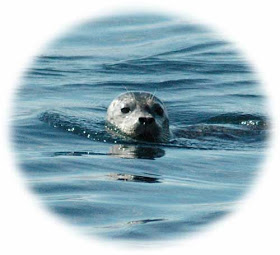Today our awesome and very generous captain chartered a Canadian zodiac to take his crew out on a wildlife-viewing adventure from a different (and much speedier) platform. This trip had a bit of everything - sunshine and blue skies to socked in fog, choppy waters that tossed us around to glassy flat-calm water. We traveled all the way out west past Race Rocks in the Strait of Juan de Fuca, and while traveling about a hundred nautical miles over six and a half hours we saw tons of birds and marine mammals. The best way to capture it all is via a species list, with some photos and notes to go along with it.
Cetaceans (don't ask me how the numbers worked out like this)
3 transient orcas - T41, T41A, and male T44
3 minke whales
3 Dall's porpose
3 harbor porpoise
 Transient male T44, surfacing with a red piece of harbor seal meat in his mouth. It's hard to see in the low-res version, so I included a close-up.
Transient male T44, surfacing with a red piece of harbor seal meat in his mouth. It's hard to see in the low-res version, so I included a close-up. Transient female T41
Transient female T41 Minke whale chillin' with a red-necked grebe
Minke whale chillin' with a red-necked grebePinnipeds
Several hundred Steller sea lions - several hundred at Race Rocks, 5-10 "harassing" the three transients, and about 20 more at Whale Rocks on the way back home
Several dozen harbor seals
A few California sea lions
Several hundred Steller sea lions - several hundred at Race Rocks, 5-10 "harassing" the three transients, and about 20 more at Whale Rocks on the way back home
Several dozen harbor seals
A few California sea lions
Two lazy Steller sea lions on Whale Rocks, with some Heermann's gulls and double-crested cormorants
Several hundred common murres
Several hundred glaucous-winged gulls
Several hundred Heermann's gulls

Several dozen rhinoceros auklets
Several dozen pelagic cormorants
Several dozen double-crested cormorants
Several dozen turkey vultures (see photo)
5-10 pigeon guillemots5-10 surf scoters
5-10 Bonaparte's gulls
3 Pacific loons
1 bald eagle
1 red-necked grebe (I didn't even know we saw this until looking at my photos, and I noticed it with the minke whale in the above photo!)
1 shearwater (!!! Species yet to be determined, but something I've never seen here)
Probably the coolest thing we saw today was the interaction between some Steller sea lions and the three transients. I've heard about hordes of Steller sea lions chasing transients away, but this is the first time I've witnessed anything like it. Transients are the true top predators in the ocean, but really only stand a chance against a large, aggresive Steller when they get it alone and offshore, and even then it takes a group of them to do it and they might leave the encounter with some sea-lion-inflicted battle scars. Right after we saw the transients make a harbor seal kill, they were continuing along to the west when we spotted about 5-10 Steller seal lions in a nearby kelp bed. The sea lions were on the surface "chasing" after the transients maybe 150 yards behind them, when the whales made a 180 degree turn and seemingly called their bluff by swimming right back at them. The whales disappeared on a long dive while the Steller's nervously poked their heads above the water to scan for dorsal fins. The whales circled around the sea lions once, and must have passed within yards of them before continuing on their way. It was exhilirating to see two of the top predators in the ocean interacting like that in the wild.


































